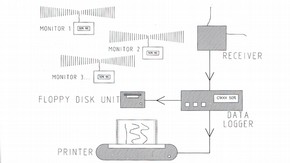Conservation Journal
July 1992 Issue 04
Data from the ether
The restrictions of hard wired environmental monitoring equipment and the high labour costs of battery operated systems have led to the interest in the use of radio transmission as a means of obtaining data from within display cases and the like. Only recently, with the relaxation of the statutes regarding low power radio transmitters at particular frequencies and developments in technology, has radio transmission become possible. This contribution describes a system purchased to satisfy data collection from an area in the Museum which is subject to continuing intentional changes of display.
Recently the Museum acquired the Meaco Museum Monitor, which is the first radio telemetry system for relative humidity and temperature data collection. It is distributed and marketed by Meaco Technology. The system's main usage within the Museum will be in the North and South Court temporary exhibition spaces curently occupied (until September 1992) by the Sovereign Exhibition.
At present the system comprises twelve combined relative humidity/temperature monitors. The number of monitors depends on the application. Each monitor has its own liquid crystal display of temperature and humidity, in addition to a small on-board transmitter. Power for the monitor is supplied by dry cell battery which will last for one year or longer depending on the application.
Communication to a base station that is interfaced to suitable data loggers is the basis of the system. In addition, colour dot matrix printer and computer disk drive units give flexibility and data security. The interval between readings is selectable and we have chosen 30 minutes. Since the system is highly flexible it may be used in a variety of other configurations. By employing suitable relay stations or hard wiring, the base station can be sited anywhere, providing the receiver unit is within approximately 200 metres of each of the monitors. Radiotelemetry enables live on-line data alarm conditions to be set to activate light emitting diodes, so as to warn curators that the conditions are out of specification. Readings may also be observed on each individual monitor's LCD.
Advantages of such a system are the collection of live data from numerous maintenance -free source points and logging the data at a central work station which can also provide hard copy on paper. The major economic advantage is the absence of wires that require channelling in walls or suitable conduits, thereby saving considerable disruption to the fabric of the building and allowing a 'movable' system.
Since the telemetry system's inherent feature is wireless data transfer, the monitors, measuring a mere 101 x 76 x 40 mm, can be moved to different locations without cumber-some wiring or fixtures; this is a highly desirable feature when installing the equipment in a temporary exhibition. A radio frequency survey and transmission test may need to be carried out by the manufacturers to ensure as far as possible that there is no interference from other radio waves of a similar nature.
Each monitor, based on the Meaco HK 100, is accurate to ±3 %relative humidity and ±1°C with no distortion of data resolution through transmission. The data loggers are from the Tracker 3000 Hybrid Data Logger series as supplied by Meaco Technology. Each logger is capable of sending 2.88 megabytes of data to floppy disks from eight input channels. The Star LC-200 printers are also off-the-shelf models; hence there is reduced cost and they are easy to replace if needs be.
The telemetry system saves many man hours in the collection, analysis and presentation of data. In the future more applications, such as UV content and lux monitors will be available. With the advance of information technology and research this data will become invaluable in the day to day running of museums. In the meantime, standard statistics and graphical packages will be used to evaluate the data.
A comparable system to that installed has reached the market and is available from Hanwell Monitors.
Suppliers
Meaco Technology,
The Woodyards,
Daux Road Industrial Estate,
Billingshurst,
West Sussex, RH14 9SJ.
Hanwell Monitors,
EES,
Oriel House,
135, Topsham Road, Exeter,
Devon, EX2 4RE.
July 1992 Issue 04
- Editorial
- Furniture timbers
- Data from the ether
- A question of research
- The technical examination & conservation of painted furniture
- Interim meeting of the ICOM 'Graphic Documents' working group held at the V&A
- A review of the Institute of Paper Conservation Conference, Manchester, April 1st - 4th 1992
- A review of 'The Imperfect Image'
- Disaster reaction planning progress
- Corrosion of metals associated with wood
